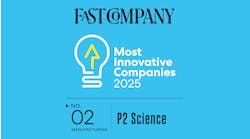Effective design and implementation underpin the success of any operational excellence program. To achieve such success, however, the chemical industry also must contend with other challenges, says Ana Khanlari, Houston-based industry marketing director, chemicals for Aspen Technology.
First, is the lack of qualified personnel. Employees with longstanding expertise are retiring and the industry is finding it hard to recruit new talent with the skills to develop or successfully implement digital technologies. In response, she notes, chemical companies are leveraging tools such as artificial intelligence (AI) to drive innovation in developing new products.
The second challenge is the investment required to upgrade or create digital infrastructures. “This is an especially big hurdle for smaller chemical companies trying to determine priorities around where to gain the maximum return on their digital investments. Supply chain management and waste reduction can be two key areas of interest to invest in digital solutions here,” notes Khanlari.
Finally, the industry’s moves toward cloud-based applications and digitalization generally pose data protection and systems security challenges. Data integrity and intellectual property protection are crucial.
Even so, Khanlari finds that initiatives that improve efficiency, reliability, productivity, safety and, ultimately, profitability of operations are leading drivers in the design of operational excellence programs.
“Digital solutions play a pivotal role here by providing tools that can forecast demand and manage production planning, model and optimize the process, define key performance indicators, and troubleshoot and predict future behavior of the equipment,” she explains.
Further, the assimilation of AI and machine learning (ML) with first-principals engineering models has led to powerful tools to simulate and optimize processes with gaps in available data or unsteady and transient conditions. Such digital technologies, including the company’s own Aspen Hybrid Models, can play an especially important role in the design of new processes, she stresses (Figure 1).
“Whether to process a new bio-based feedstock or to recycle waste plastic, digital solutions can provide a realistic view while experimental data are scarce, difficult to gain, and scale is limited,” adds Khanlari.
Sustainability increasingly factors into operational excellence programs and associated digital technologies, too, with metrics such as emissions reduction and waste generation under the spotlight.
As an example, Khanlari cites a SABIC plant that wanted to speed up progress toward its 2025 goal of cutting greenhouse gas emissions, energy consumption and fresh water use by 25% compared to 2010.
A digital twin of the plant’s utility system, made using Aspen Utilities Planner, led to a 130-GJ/hr decrease in energy use from the plant — equivalent to a reduction in carbon dioxide (CO2) emissions of nearly 60,000 tons/yr, assuming natural gas usage.
SABIC now is following up on that 2021 project by planning to deploy an online energy optimizer as a real-time decision-making tool to further improve the plant’s processes.
KEY IMPETUS
Sustainability is a critical driver in operational excellence programs, right across the value chain, finds Aveva, Cambridge, U.K. “According to a PwC research, today’s existing technology can help companies reach more than 70% of the targets that underpin the United Nations Sustainable Development Goals over the next decade,” notes Stephen Reynolds, industry principal — chemicals.
Aveva is working alongside its customers to create operational excellence programs to leverage the power of the industrial ecosystem and deliver technologies to optimize engineering, operations and performance while also helping companies reach their environmental, safety and governance targets.
“We take maximum advantage of our data management and modeling solutions to quickly convert raw data into insightful information to inform the fastest, most accurate decisions,” says Reynolds.
So, once a program gets the go-ahead, Aveva can deliver a scalable and maintainable evergreen digital twin that supports the entire plant lifecycle — while AI and cloud computing speed up engineering projects from concept to full production.
“Once the plant is live, our digital engineering blueprint is connected with real time data to become a live digital twin. As the project workflow progresses, other technology layers can be added to ensure quality and yields that are aligned to the customer´s vision and strategy,” he adds (Figure 2).
The idea is to make chemical companies as agile as possible in their responses to changing market demands while at the same time maintain product quality with minimum wastage, maximum safety and optimum sustainability, he stresses.
As an example, he cites a project at Covestro, Leverkusen, Germany, where the Aveva PI System operations data management platform gathers data from more than 4,000 energy-specific tags across its plants, regional sites and business units.
This wider view of energy use enabled Aveva’s team to uncover trends, reveal insights and make adjustments as necessary, allowing Covestro to cut energy consumption by 30% per ton of product and CO2 emissions by 39% per ton — even as production capacity has increased.
“The program earned an energy management certification from the German government, securing major tax rebates,” adds Reynolds.
China National Bluestar turned to the same technology when it wanted to increase production while reducing energy and material costs. However, managers at the company’s headquarters in Beijing lacked real-time access to onsite data for corporate-wide reporting and planning, which hampered efforts to quickly identify problems and deploy best practices across sites.
Using the Aveva PI system, the company could better understand what was happening across 12 plants spread across nine provinces. The system’s combination of improved performance monitoring and computing power provided much-needed visibility into plant operations while increased automation has made reporting faster and more accurate. More than 30 production units have been optimized. At one of its newly refreshed sites, Bluestar is saving $200,000/yr in steam costs alone.
To create a successful operational excellence program and leverage digital transformation to the full, chemical companies must have a clear view of their current challenges as well as their short- and long-term goals, counsels Reynolds.
“A digital transformation strategy and roadmap should then be tailored to the specific needs and objectives of each company. In our experience, digitally scalable and maintainable technology aligned with industry expertise is critical to achieving desired returns on digital investments. A proven record is also vital as is the possibility to run applications in the cloud. Even if they are not ready for cloud, they should make sure the digital investment will last as long as possible,” he emphasizes.
Another aspect is the user interface. Applications that are easy to deploy, use and maintain will maximize return on investment and also attract the incoming generation of workers, who generally steer clear of out-of-date, conservative companies.
Today’s available digital tools enable easy access to information, collaboration and overall agility, so organizations can reach their profitability goals aligned with their sustainability targets.
“Operational excellence is critical for enabling business continuity, sustainability and profitability. Digital technology supports and drives operations by helping chemicals companies to operate efficiently and safely, increase competitiveness, and retain talent,” Reynolds concludes.
FOREMOST FACTOR
A survey of over 100 senior operations staff at refining and petrochemical companies identified operational excellence as the top factor for remaining competitive and efficient, according to KBC, Walton-on-Thames, England, which carried out the survey.
“While still key, it is somewhat outdated. Most companies have already gone down the path and have established effective business processes that work best for their environment. There are still a few companies that need to focus more on integration and develop a road map,” notes Shane Fitzsimmons, principal consultant, business development consulting/sales.
Secondly, the survey found that operational excellence is a means to drive operational discipline to improve business performance. Importantly, before moving towards a digital transformation, all organizations must demonstrate repeatable results through the execution of safe operations.
Finally, digitalization itself is a means to codify operational excellence and drive to the next level of performance with predictable results. “The use of AI/ML on big data sets increases production efficiency and lowers cost per operating unit with higher overall equipment effectiveness (OEE),” stresses Fitzsimmons.
However while many chemical companies have expertise in certain areas, this varies enormously depending on their scale and end products. KBC’s response to this variation is to take a holistic approach to the design of operational excellence programs. This involves pursuing a top-down operating model to maximize value creation while providing technical expertise across a particular plant or site’s functions. At the same time, KBC’s management change strategy focuses on the frontline to drive sustainable behavioral change. “Hand-in-hand with these two is the delivery of digitalization, automation and IT/OT [information technology/operational technology] integration options to control systems to automate plant and systems and embed the use of technology in the way of working,” adds Fitzsimmons.
To illustrate, he cites a two-year-long project at an integrated refinery and petrochemical complex in Southeast Asia. The operator, feeling it was lagging behind industry peers, wanted to pursue a strategy of operational, commercial and human performance excellence.
KBC’s strategy involved more than 50 of its consultants focusing on four work streams: value chain optimization, process and energy improvement, utility system optimization, and reliability and availability.
Using the holistic methodology, the consultants were able to make and implement many recommendations.
For example, they evaluated and implemented value, reliability and stability improvement opportunities across the entire complex to improve OEE. The application of leading-edge digital technology supported the development and deployment of these initiatives. Such optimized work processes also supported the creation of high-performing work teams who benefitted from coaching and mentoring on their use. Models and tools left behind after the project helped the company sustain continuous investment.
In the two years since the project was completed, the company has shaved $1/barrel off the cost of refining oil, improved OEE by 6% and reduced working capital tied up in the intermediate inventory by 13%. The customer also reports an improved workforce competency level and a much higher performing work team culture.
Another example involves a U.S. refinery in the final stages of a modernization and expansion project. It identified a need to restructure to improve performance in advance of commissioning new units.
Here, KBC applied an operational excellence methodology to identify performance improvement initiatives to implement before and after expansion. These plans included quick win opportunities. The consultants also developed an organization structure to effectively start up and run the newly configured refinery post expansion; these include team charters and job profiles to ensure clear, aligned accountabilities throughout the organization.
To incorporate key strategies into regular planning and optimization processes, KBC updated the linear programming sub-model. Organizational effectiveness was improved by doubling the mean time between failures for rotating equipment, which increased production throughput and reduced alarm frequency.
KBC identified more than $100 million/yr of potential yield and energy opportunities for the operator. In addition, it pinpointed about $50 million/yr of opportunities available for immediate implementation that required no capital investment. The decrease in environmental reportable incidents — from 16 to four year-over-year — resulted in savings of $5 million in fines.
Tailoring the design of operational excellence programs to each asset’s starting point and aligning the programs to the targeted outcomes is crucial, believes KBC. An operational excellence program should focus on specific tangible goals and evolve over time. A program should place at its core three factors: build in results assurance and sustainability from the start; understand the balance between tools and capabilities; and focus on governance.





